Arrows are probably the most important elements in a message sequence chart. They represent the actual messages. Arrows can be specified using the following syntax.
entitynamearrowsymbolentityname[attr=value|style, ...];
arrowsymbol can be any of ‘->’, ‘<-’ or ‘<->’, the
latter for bidirectional arrows. a->b is equivalent to
b<-a.
This produces an arrow between the two entities specified
using a solid line. Using ‘>’/‘<>’, ‘>>’/‘<<>>’ or
‘=>’/‘<=>’, will result in dotted, dashed or double line
arrows, respectively.
These settings can be redefined using styles, see Defining Styles.
It is possible to omit one of the entity names, e.g., a->;.
In this case the arrow
will expand to/from the chart edge, as if going to/coming from an
external entity.
It is possible to specify multi-segment arrows, such as a->b->c
in which case the the arrow will expand from ‘a’ to ‘c’, but
an arrow head will be drawn at ‘b’, as well. This is used to
indicate that ‘b’ also processes the message indicated by the
arrow. The arrow may contain any number of segments, and may also start
and end without an entity, e.g., ->a->b->c->d->;. As
a syntax relaxation, additional line segments can be abbreviated with a
dash (‘-’), such as a<=>b-c-d;. Subsequent segments inherit
the line type and direction of the first one. This enables quick
changes to these attributes with minimal typing, as only the first
arrow symbol needs to be changed. As a further possibility, different
arrow symbols can also be used for different segments, such as
a->b=>c>>d-e;, but all the arrow symbols must be of the same
direction. It is therefore not possible to mix arrows of different directions,
such as a->b<-c; or a->b<->c;. Note that specifying different
arrow symbols affect only the line attributes of the segments, not the
arrowhead, text or other attributes.
If the entities in a multi-segment arrow are not listed in the same (or exact reverse) order as in the chart, Msc-generator gives an error and ignores the arrow. This is to protect against unwanted output after rearranging entity order.
Arrows can also be defined starting and ending at the same entity,
e.g., a->a;. In this case the arrow will start at the vertical
line of the entity and curve back to the very same line. Such arrows
cannot be multi-segmented.
Only non-grouped entities can be used in an arrow definition.
If an entity used to define an arrow is not shown due to the collapse of
its group entity, Msc-generator will automatically use the collapsed
group entity when drawing the arrow, instead. If the arrow becomes degenerate
(spanning between only a single collapsed group entity) or disappears
entirely, an indicator will be shown instead, if the ‘indicator’
attribute of the collapsed group entity was set to yes (default).
Sometimes one want to express that a message is lost. You can do this in
Msc-generator in two ways. Either, you can add an asterisk between the two
entities where the message is lost; or you can add a ’lost at’ clause after
the arrow specification before the label or attributes. This causes a small x
to be drawn at the place specified and the dimming of the remainder of the
arrow.
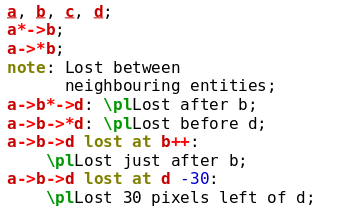 |
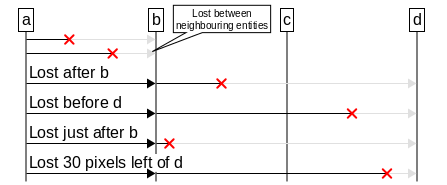 |
The first three ones are the quick one. The message lost will be indicated
around the entity after or before the asterisk. Specifically, it will be
between this and its neighbouring visible entity. If that visible entity
is also part of the arrow, the loss will be at one third the distance between
them, else it will be halfway.
Using the second form, you can specify exactly where the loss happened.
It can be placed onto an entity, left or right from it, or between two entities.
These are specified as ‘lost at <entity>’, ‘lost at <entity>-’,
‘lost at <entity>+’ or ‘lost at <entity1>-<entity2>’, respectively.
You can add two plus or minus symbols to increase distance.
You can also specify any offset in addition by adding a number after,
such as in ‘lost at <entity> <number>’. The number will be interpreted in
pixels and shifts the vertical left or right depending on its sign.
The appearance of the loss symbol (the x) can be influenced using the
x.line.width, x.line.color and the x.size attributes. The
latter takes the same values as arrowhead sizes: tiny, small,
normal, big or huge, with normal as default.
The appearance of the lost portion of the message can also be influenced via the
lost.text.*, lost.line.* and the lost.arrow.* attributes. Anything
specified here will be added to the text, line and arrowhead format of the arrow.
Currently only the color of the line and the arrowhead is overlaid with
++white,128 (for plain designs),
making them weaker, but you can change to dash lines, specifly a narrower line or
empty arrowheads.
Arrows can have the following attributes.
labelThis is the text associated with the arrow. See Labels for more information on how to specify labels. In Msc-generator the first line of the label is written above the arrow, while subsequent lines are written under it. Future versions may make this behaviour more flexible.
text.*All text formatting attributes described in Common Attributes can be used to manipulate the appearance of the label[19].
numberCan be set to
yes,noor to a number, to turn numbering on or off, or to specify a number, respectively. See Numbering.refnameCan be set to any string and is used to give a name to the arrow, which can be used to reference this arrow. Use the
\r(name)escape in labels to insert the number of the referenced arrow. See Numbering.compressCan be set to
yesornoto turn compressing of this arrow on or off. See Compression and Vertical Spacing.vspacingCan be set to a number interpreted in pixels or to the string
compress. Governs how much vertical space is added before the arrow (can be negative). This attribute is another form (superset) of thecompressattribute;compress=yesis equivalent tovspacing=compress, whereascompress=nois equivalent tovspacing=0.angleThis takes a number in degrees and makes the arrow slanted. Arrows pointing to the same entity cannot have such an attribute. This attribute takes its default value from the
anglechart option (or is zero in the absence of such an option, which corresponds to horizontal arrows).slant_depthThis is similar in effect to the
angleattribute, but instead of specifying the angle of the slant in degrees, you can use this attribute to specify how many pixels shall the end of the arrow be below the start of it. If you specify both theangleattribute andslant_depththe latter takes effect.colorThis specifies the color of the text, arrow and arrowheads. It is a shorthand to setting
text.color,line.colorandarrow.colorto the same value.line.color, line.widthSet the color and the width of the line, see Common Attributes.
line.cornerThis attribute specifies how the line shall be drawn at corners. It impacts boxes and entities drawn with this line, for arrows it is effective for arrows that start and end at the same entity. Its value can be
none,round,bevelornote. See the example below. Settingline.cornerwithoutline.radiuswill result in the default radius of 10.line.radiusFor arrows starting and ending at the same entity, this specifies the roundness of the arrow corners. 0 is fully sharp (equivalent to
line.corner=none, positive values are meant in pixels, a negative value will result in a single arc (for any corner setting). If onlyline.radiusis set and notline.cornerthe result will be a round corner.
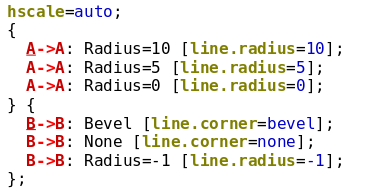 |
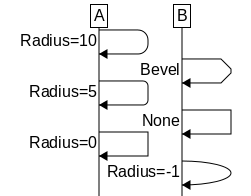 |
arrow.sizeThe size of the arrowheads. It can be
tiny,small,normal,bigorhuge, with small as default.arrow.colorThe color of the arrowheads.
arrow.typeSpecity the arrowhead type. The values can be
half,line,empty,solid, which draw a single line, a two-line arrow, an empty triangle and a filled triangle, respectively. The above 4 types also exist indoubleandtriplevariants, which draw two or three of them.sharpandempty_sharpdraws a bit more pointier arrowhead, filled or empty, respectively.diamondandempty_diamonddraws a filled or empty diamond, whiledotandempty_dotdraws a filled or empty circle. Specifyingnonewill result in no arrowhead at all. This attribute sets both theendtypeandmidtype, see below.arrow.endtypeSets the arrow type for arrow endings only. This refers to the end of the arrow, where it points to. In case of bidirectional arrows, both ends are drawn with this type. It defaults to a filled triangle.
arrow.midtypeThis attribute sets the arrowhead type used for intermediate entities of a multi-segment arrow. It defaults to a filled triangle.
arrow.starttypeThis attribute sets the arrowhead type used at the starting point of an arrow. It defaults to no arrowhead.
arrow.xmul,arrow.ymulThese attributes change the width or the height of the arrowhead. The default value is ‘
1’. They are multipiers, thus the value of ‘1.1’ results in a 10% increase, for example.
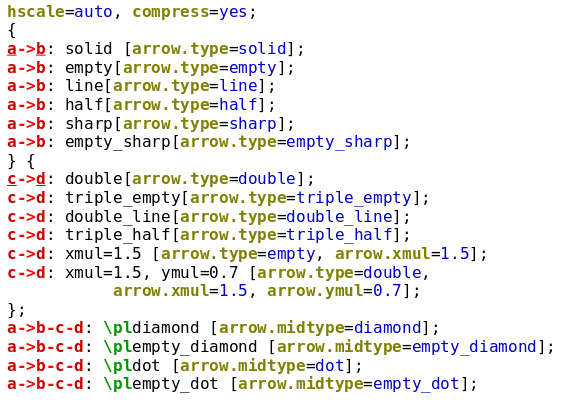 |
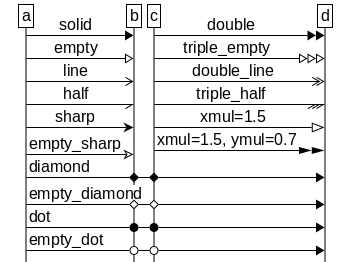 |
lost.text.*The values specified here will be added to the values of
text.*when drawing the label of the lost part of the message.lost.line.*The values specified here will be added to the values of
line.*when drawing the line of the lost part of the message.lost.arrow.*The values specified here will be added to the values of
arrow.*when drawing the arrowheads in the lost part of the message.x.sizeThe size of the loss symbol for lost messages. It can be
tiny,small,normal,bigorhuge, with normal as default.x.line.width,x.line.colorThe linewidth and color of the loss symbol for lost messages.
Note that default values can be changed using styles, see Defining Styles.
When typing block in front of any arrow definition, it will become
a block arrow. The label of a block arrow is displayed inside it.
In addition to the attributes above, block arrows also have fill and shadow
attributes, similar to entities.
All arrowheads explained above for regular arrows are supported, except the
double and triple ones. In general, types with empty in
them, draws a variant of the arrowhead which is not taller that the body of the
block arrow. The ones with line draw the same as the ones without.
Three additional types empty_inv, ‘stripes’ and
‘triangle_stripes’ types are supported, as well.
See the example below for a detailed list of all types supported for block arrows.
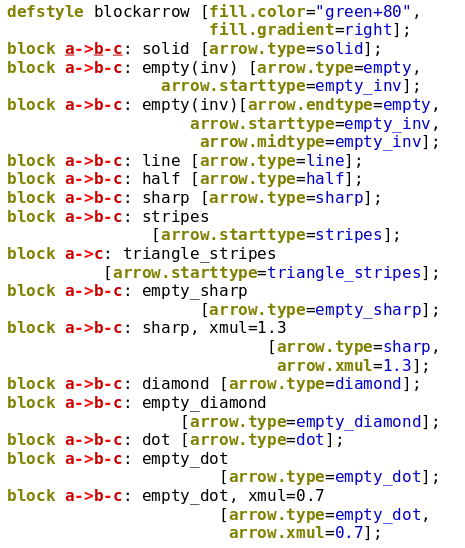 |
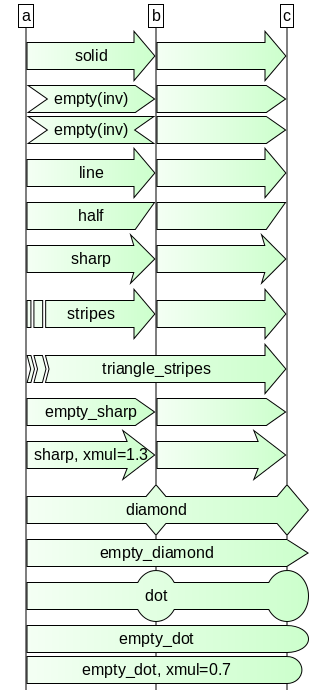 |
If the arrow has multiple segments and the type of the inner arrowheads is
either of half, line, empty, solid or sharp
the block arrow is split into multiple smaller arrows. In this case the arrow
label is placed into the leftmost, rightmost or middle one of the smaller
arrows, depending on the value of the text.ident attribute.
It is also possible to use different arrow symbols leading to different line types, but only if the middle arrow type is such that the arrow is split into multiple contours. If not, the whole arrow is drawn with the line type of the first segment.
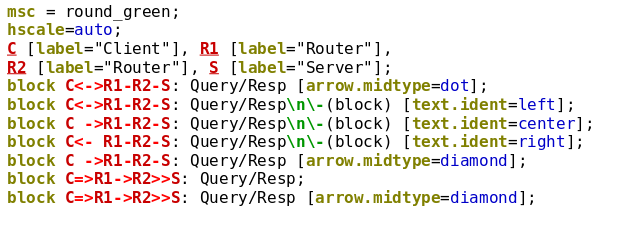
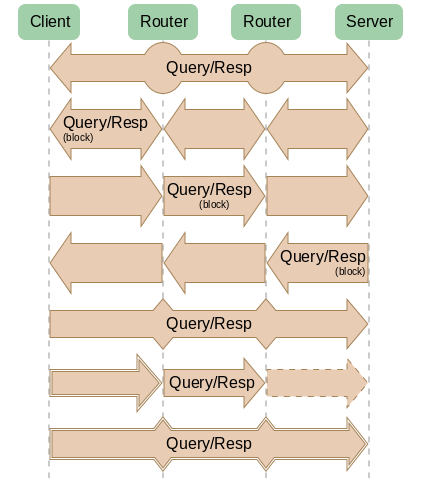
Block arrows can also be slanted using the angle attribute.
[19] A
special note on left and right text margins (to be specified via \ml()
and \mr() escapes). Msc-generator always adds enough text margins
to prevent the label to overlap with the arrowhead. Thus, if you specify less
margin, it will have no effect.